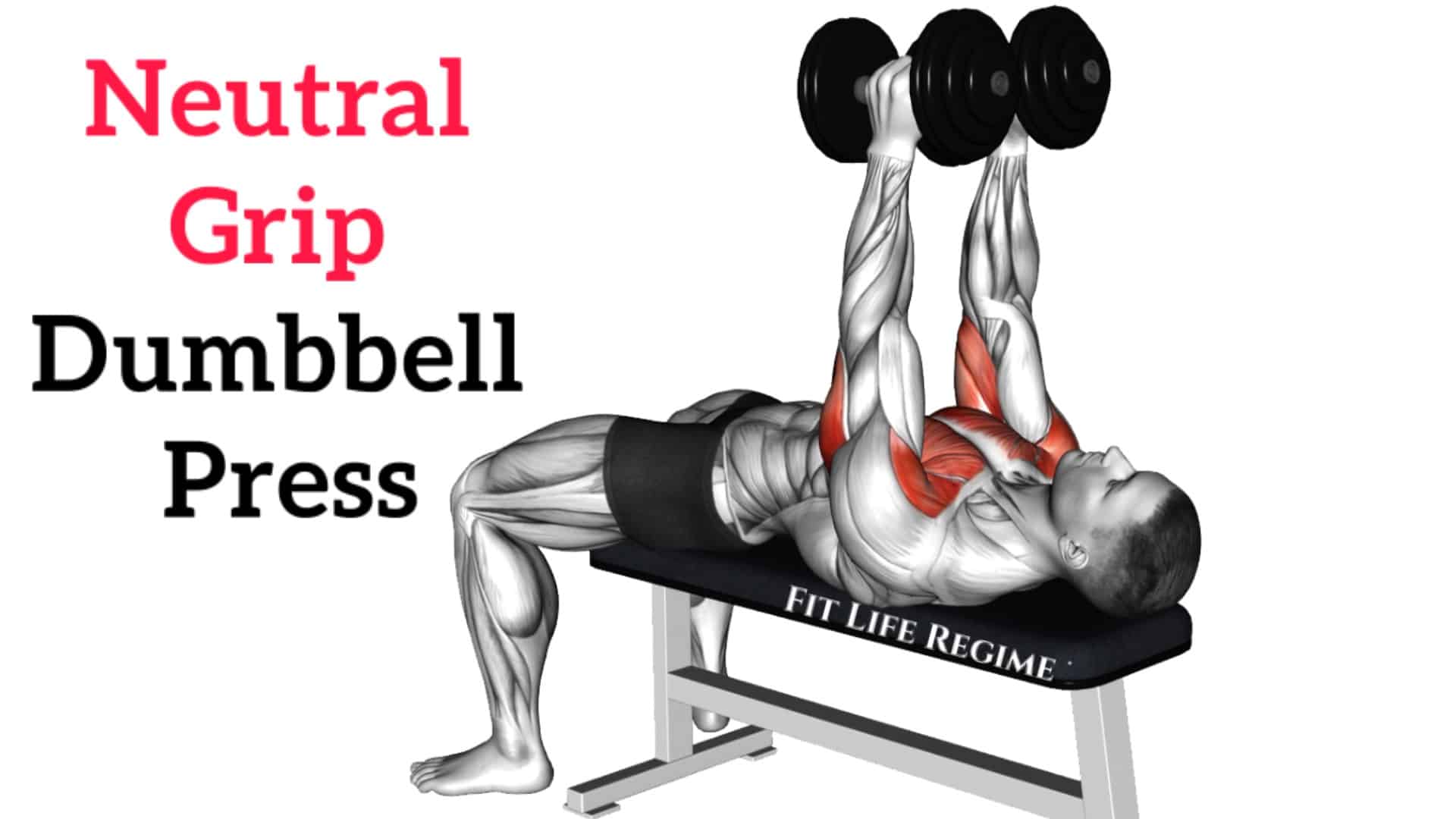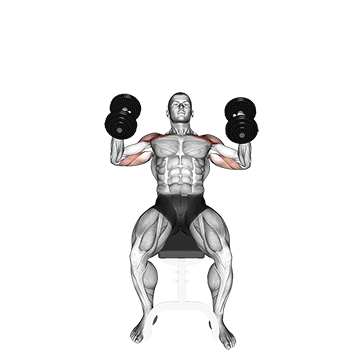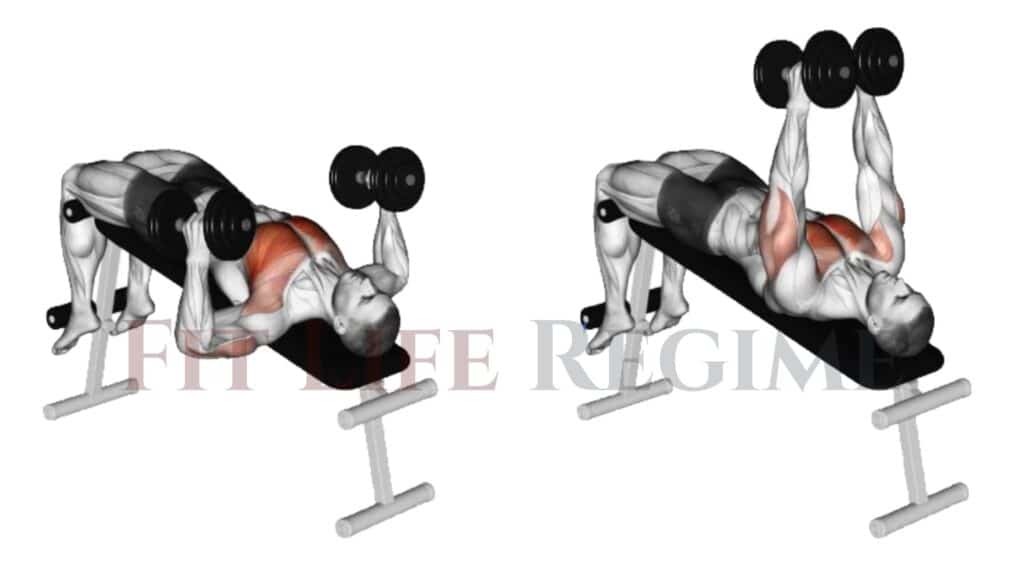The barbell bench press is one of the most popular chest-building exercises, but many lifters suffer from shoulder pain when using the traditional barbell bench.
The neutral-grip dumbbell press is a great bench press alternative because it emphasizes chest and triceps without causing shoulder pain. Because your palms are facing each other, it reduces the strain on your shoulders.
Whether you are a strength sport athlete or a regular gym goer, I recommend adding the neutral grip chest press to your chest training. You will feel the results for yourself.
In this article, you will learn everything: how to do a neutral grip dumbbell press correctly, its benefits, tips and form, and its best variations.

- Neutral Grip Chest Press Muscles Worked
- How To Do Neutral Grip Dumbbell Chest Press
- Tips and Form
- Neutral Grip Dumbbell Press Benefits
- Best Variations Of Neutral Grip Dumbbell Chest Press
- 1. Incline Neutral Grip Dumbbell Press
- 2. Decline Neutral Grip Dumbbell Press
- 3. Close Grip Neutral Dumbbell Press
- References
Neutral Grip Chest Press Muscles Worked
- Primary Muscles: Pectoralis Major (Chest)
- Secondary Muscles: Triceps Brachii and Anterior Deltoids (Front Shoulders)
- Stabilizing Muscles: Rotator Cuff Muscles, Serratus Anterior, Rhomboids and Biceps brachii (stabilizing the elbow joint)
How To Do Neutral Grip Dumbbell Chest Press
- Sit down on the bench with a dumbbell in each hand. Use a weight that’s challenging but allows you to maintain good form.
- Lie back on the bench. Use your knees to help kick the weights up, one at a time, so you can hold them at chest level with your arms bent.
- The palms of your hands should be facing each other in a neutral grip.
- Position the dumbbells directly above your chest with your arms fully extended. This is your starting position.
- Inhale and slowly lower the dumbbells towards the sides of your chest.
- Keep your elbows at about a 45-degree angle to your body.
- Once the dumbbells are about even with your chest or slightly below (ensure your shoulders feel comfortable), pause briefly.
- Exhale and push the dumbbells back up to the starting position, contracting your chest muscles as you do so.
- Your arms should be fully extended at the top, but don’t lock out your elbows.
- Repeat for the desired number of repetitions, and then carefully lower the dumbbells to your sides or use your knees to assist in dropping them safely to the ground.
Tips and Form
- Maintain a natural arch in your lower back, but don’t exaggerate it. Your head, upper back, and buttocks should remain in contact with the bench.
- Hold the dumbbells with a neutral grip, palms facing each other. Ensure a firm but not overly tight grip.
- Keep your elbows at about a 45-degree angle relative to your torso. Avoid flaring the elbows out excessively or tucking them too close to your body.
- Lower the dumbbells until they are level with your chest. Press them back up to full arm extension without locking out the elbows.
- Ensure smooth and controlled motion both during the lowering and pressing phases. Avoid using momentum or bouncing the weights.
- Inhale as you lower the dumbbells, and exhale as you press them up.
- Start with a light set to warm up the muscles and prepare the joints. This can prevent injury and improve performance.
- Keep your core engaged throughout the movement. This adds stability and protects the spine.
- The weight is likely too heavy if you can’t maintain proper form. It’s better to perform the exercise correctly with a lighter weight than to risk injury with a heavier weight.
- Focus on squeezing and contracting the chest muscles as you press up. This enhances muscle activation.
- When strength building, it is recommended to choose a heavier weight that makes the last rep of each set very challenging but still maintainable with proper form. For muscle building, use a moderately heavy weight.
| Goal | Sets | Reps | Rest |
|---|---|---|---|
| Strength Building | 3-5 | 4-6 | 2-3 minutes between sets |
| Muscle Building (Hypertrophy) | 3-4 | 8-12 | 60-90 seconds between sets |
| Endurance and Toning | 2-3 | 12-20 | 30-60 seconds between sets |
| General Fitness or Maintenance | 3 | 8-10 | 60-90 seconds between sets |
Neutral Grip Dumbbell Press Benefits
You might be motivated to do neutral grip dumbbell press exercises for several reasons, and I’ve mentioned a few below.
- Many lifters use the neutral-grip dumbbell press to build a strong chest, especially after surgery or shoulder injuries.
- Neutral grip chest press requires more muscular control than barbells, enhancing kinaesthetic awareness.
- The neutral grip allows for a deeper stretch of the chest muscles during the lowering phase of the press, which can improve muscle activation.
- It allows for greater joint safety and stabilization and allows the joints to move naturally within their range of motion.
- The neutral grip can lead to greater triceps engagement than the standard grip.
- Dumbbell variations allow for a greater range of movement (ROM), leading to increased muscle fibers recruited.
- Hammer press with dumbbell allows unilateral training (training one limb at a time), increases core stability, and improves muscular imbalances.
- It is also perfect for the at-home exerciser with limited space.
Best Variations Of Neutral Grip Dumbbell Chest Press
The neutral grip dumbbell press can be done in various ways to suit your fitness level.
- If you are new to performing a neutral grip bench press, start with a lighter weight.
- If you are looking for a more advanced variation to stimulate different muscle fibers in the chest, then you should try incline and decline neutral grip press.
1. Incline Neutral Grip Dumbbell Press
Pressing with a neutral grip on an incline bench can help develop the upper pectoral muscles and add some variety to your program.
You also increase the range of motion at your elbow joints when you perform it on an incline bench.

How To Do
- Lie on an incline bench with a dumbbell in each hand and in a neutral grip.
- Hold the weights above you at shoulder height.
- Now, extend the weights to the top overhead, feeling a good chest muscle contraction.
- Lower the dumbbells to the starting position and feel a good stretch in your pecs.
- Repeats.
2. Decline Neutral Grip Dumbbell Press
The decline neutral grip chest press is a compound exercise that primarily targets the lower chest. However, the triceps and shoulders are secondary movers during the exercise, and they also get a lot of work.
Using a neutral grip is a safe alternative to the pronated grip as it protects the shoulder joints, which is a great advantage. So, include the decline hammer-grip dumbbell bench press in your chest routine for great results.

How To Do
- Grab a dumbbell in each hand with a neutral/hammer grip and lie on a decline bench.
- Hold the weights above you at shoulder height.
- Now, extend the weights up and feel a good chest muscle contraction.
- Lower the dumbbells to their starting position and feel your pecs stretch.
3. Close Grip Neutral Dumbbell Press
When you do this, you will feel your triceps and inner chest muscles engage even deeper.
Keeping the elbows closer to the body promotes better elbow stability and reduces strain on the joints.
References
- Muyor JM, Rodríguez-Ridao D, Oliva-Lozano JM. Comparison of Muscle Activity between the Horizontal Bench Press and the Seated Chest Press Exercises Using Several Grips. J Hum Kinet. 2023 Apr;87:23-34. Published online 2023 Apr 20. doi: 10.5114/jhk/161468.
- Barnett, C., Kippers, V., & Turner, P. (1995). Effects of variation on the bench press exercise on the EMG activity of five shoulder muscles. Journal of Strength and Conditioning Research, 9(4), 222–227.

Manish is a NASM-certified fitness and nutrition coach with over 10 years of experience in weight lifting and fat loss fitness coaching. He specializes in gym-based training and has a lot of knowledge about exercise, lifting technique, biomechanics, and more.
Through “Fit Life Regime,” he generously shares the insights he’s gained over a decade in the field. His goal is to equip others with the knowledge to start their own fitness journey.
